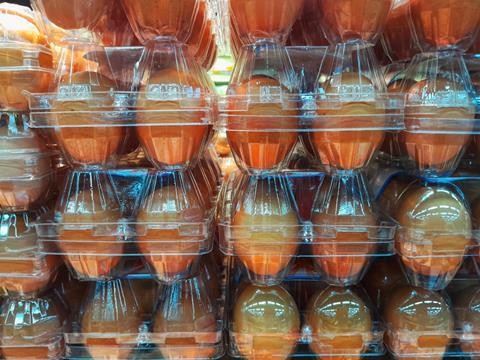
Only 28% of PET tray material was collected for recycling in 2022, according to ICIS. In the face of confusion around policy, cheap rPET imports, and slowing investment, what can be done to ensure the PET industry meets its 2030 PPWR targets? Matt Tudball, Senior Editor for Recycling at ICIS, takes a closer look.
Regulatory uncertainty, multi-material compositions, limited collection rates and a competitive landscape pose significant challenges for polyethylene terephthalate (PET) tray recycling in Europe, but the industry is working to make it a reality, albeit at a slower pace than some would like.
The 3rd PETCORE EUROPE Thermoforming Conference in Dijon, France in May brought the PET tray market together to discuss how to move things forward at scale and pace.
Some of the key issues to be addressed included:
- Improving collection and sorting rates for PET trays across EU Member States
- Advancing technologies to make trays more recyclable and improve recycling yields
- Where do trays fit in amongst European legislation?
- Creating a level playing field for all of Europe’s plastic recycling sectors
Collection and sorting
ICIS data show that in 2022, of the 1,070,000 tonnes of PET that went into trays in Europe, only 300,000 tonnes was collected for recycling – that’s just a 28% recovery rate.
Collection data is a major challenge as only a handful of countries have readily available data on tray collection volumes, such as France, Belgium and Portugal. Until 2024, many countries in the EU considered PET trays as non-recyclable.
There are several early-stage tray recycling projects across Europe but due to limitations on collection and sorting, regular consistent supply of tray recyclate in Europe is still limited and must increase.
The differences in collection and sorting systems across Europe together with variances in quality and yields makes accurate pricing of tray bales and recyclate challenging. Many market participants canvassed both ahead of and at the PETCORE event stated the market has not yet reached a level of commercialisation where a consistent price assessment can be given.
Tray packaging composition and end use applications also present challenges to collection and sorting.
Sorting technology needs to differentiate between monolayer and multilayer trays, sort colored and opaque trays from colorless material, and food-application from non-food application trays. Advancements in sorting techniques such as AI may help ease this process, but it still needs to be scaled.
With the Packaging and Packaging Waste Regulation (PPWR) now in force, the tray industry is under pressure to improve collection and sorting rates to ensure they can meet the 2030 recycled content targets set out in the PPWR, including 30% for PET contact sensitive packaging.
Improving recyclability
Work continues to improve plastics recyclability in general, and for trays, one element is the work between the European Committee for Standardisation (CEN) and the Commission that has been developing voluntary standards on design-for-recycling (DfR) for plastic packaging including PET, and this will help improve recyclability and sorting of PET trays.
Clearer labelling of PET trays helps educate the consumer on how and where to recycle their rigid PET, with the aim of increasing collection rates.
One major challenge lies in delamination of multilayer and multimaterial trays. Under the guise of reducing plastic use, many brands are looking for ever-thinner applications and this leads to more demand for multilayer films which are used on a wide variety of food packaging.
But multilayer films are harder to recycle, with the addition of polyethylene (PE) and ethylene vinyl alcohol (EVOH) leading to cloudiness and haze in the recyclate, and adhesives to fix the layers leading to gel spots and discoloration of the output.
Advances in delamination technology can help improve the recycling rates of multilayer trays, but this comes at a cost, and again, this technology still needs to be scaled to help reach the 2030 targets.
Article 6 of the PPWR states all packaging placed on the market shall be recyclable, but this could be a big issue, especially multi-layer and multi-material trays.
The PPWR sets out three ‘Recyclability Performance Grades’ – A, B and C – which assess the recyclability per unit, in terms of weighting. Grade C, the lowest grade, requires that the unit (the PET tray in this case) is 70% recyclable. If not, from 2030, it cannot be placed on the market.
Requirements get stricter from 2035 and 2038, where only trays that are 80% recyclable can be placed on the market.
PETCORE’s Tray Circularity Evaluation Platform (TCEP) is working with the industry to help meet these guidelines but there is always the danger of a shift away from R-PET altogether to other packaging types without such strict requirements under PPWR.
Regulatory challenges
There is frustration from the industry that they must wait until at least the end of 2026 for the methodologies on the calculation and verification of the recycled content going towards the PPWR target. The lack of clarity is harmful to the industry because it ‘does not get along well with business’ as one speaker noted.
Leonor Garcia of regulatory consultancy E&ACT highlighted that for trays where the main component is PET, it remains unclear if the other components (lids, labels, absorbent pads) also must comply with the 30% target, or with the 10% target for non-PET contact sensitive packaging laid out in the PPWR. As Garica states, this is very open to interpretation which adds to the uncertainty.
Investment decisions need to be made across the chain, from collection and sorting to delamination and deinking and chemical recycling but an uncertain regulatory landscape slows these decisions or can even stop them dead in some cases
Level playing field
Conversations across recycled plastics sectors currently focus on the state of the market and genuine concerns about European competitiveness in the global recycling space.
Based on the current text, the PPWR allows for recycled material from outside the EU to count towards the recycled content targets. This immediately raised concerns from recyclers that lower-priced recycled PET (R-PET) imports will head to Europe, undercutting EU-based recyclers who face significantly higher feedstock, energy and labor/production costs.
European recyclers want the yet-to-be-published PPWR implementing decisions to lay down clear guidelines for imports, ensuring the standards expected of and imposed on EU material apply to material from third countries. Equally important, they want imported material to be checked and audited to ensure it complies with the same standards European material is required to meet.
There is another challenge to address too – perhaps one of the largest facing the market: getting brands and consumers on board with tray recycling.
Many brands want to use more recycled content in their products either because of their own voluntary sustainability targets or because they believe it is what the consumer wants, but in recent years there has been a shift away from a sustainability mindset to a cost savings one.
The tray-to-tray market is growing at a time when virgin PET (due to costs) has become a more attractive option for many tray producers not yet beholden to mandatory recycled content targets like their PET beverage bottle counterparts.
The chart below shows the spread between the mid-point of the free delivered (FD) Europe PET bottle grade resin price and the FD northwest Europe (NWE) colorless R-PET flake price.
Recyclers across the R-PET market complain of squeezed margins due to high bale prices which they struggle to pass down the chain. Monomaterial and multimaterial tray bales may be much lower in price than bottle bales right now, but some sellers are struggling to find regular offtake for the material due to limited buying interest.
The reason appears to be twofold: With over four years until the 30% target, a high proportion of buyers in the tray sector do not feel the pressure of adding more recycled content to products above current levels. The second is the attractiveness of virgin PET, which is often lower in price and more consistent in quality. Without a strong financial incentive, buyers currently lean towards the lower cost option in most cases.
Market outlook
If buyers do not want to pay for the tray recyclate due to the quality and cost, how do recyclers fund the investments they need to improve the quality and make tray recyclate more attractive and produced at scale?
Demand should increase between now and 2030 as more brands understand the requirements of the PPWR and the penalties they face if they fail to hit the recycled content targets. Details of the penalties are to be set out by Member States but are hoped to be significant enough to encourage the use of recycled material.
The status of R-PET imports should also be laid out in a new implementing decision of the Single Use Packaging Directive (SUPD) currently being drafted by the Commission for publication in Q4 2025. This will allow European recyclers to understand how those imports will be checked and used and allow them to adjust business plans accordingly.
More Deposit Return Schemes (DRS) across Europe in the coming years may also help with PET tray collection and sorting as it removes the bottle fraction from the stream. We may even see calls for similar collection systems for trays appear in Europe, though this waits to be seen.
But there is still work to be done, including ensuring PET tray design meets the requirements laid out in Article 6 of the PPWR. The market cannot get complacent and must keep working cross-value chain to improve the recyclability of PET trays in the initial design phase to keep them on the market once the PPWR comes into effect.
If you liked this story, you might also enjoy:
The ultimate guide to the Packaging and Packaging Waste Regulation in 2025
How are the top brands progressing on packaging sustainability?
Everything you need to know about global packaging sustainability regulation in 2025
The key to increasing the use of reusable packaging in supermarkets

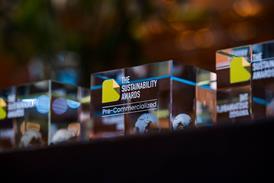

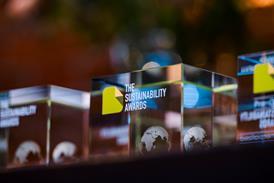
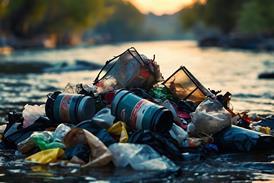
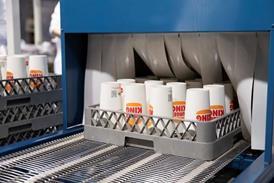






No comments yet